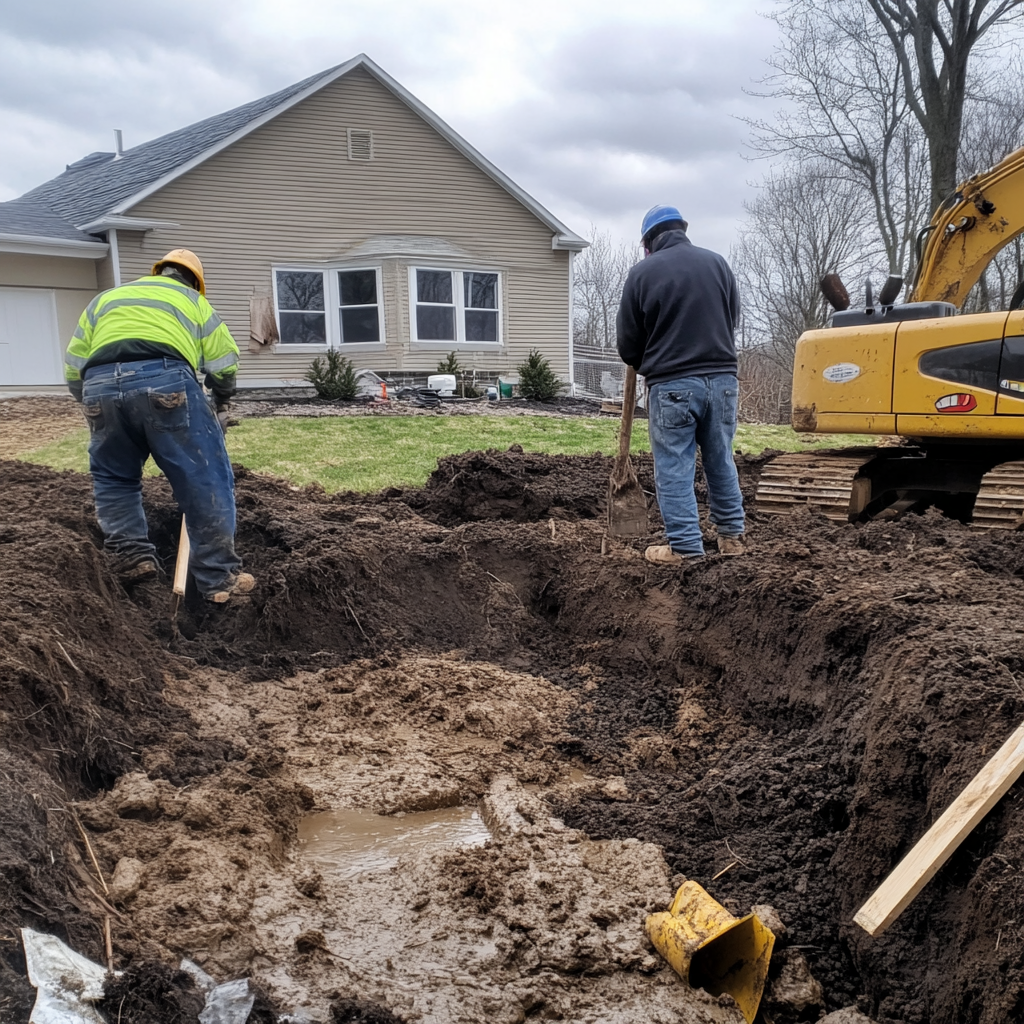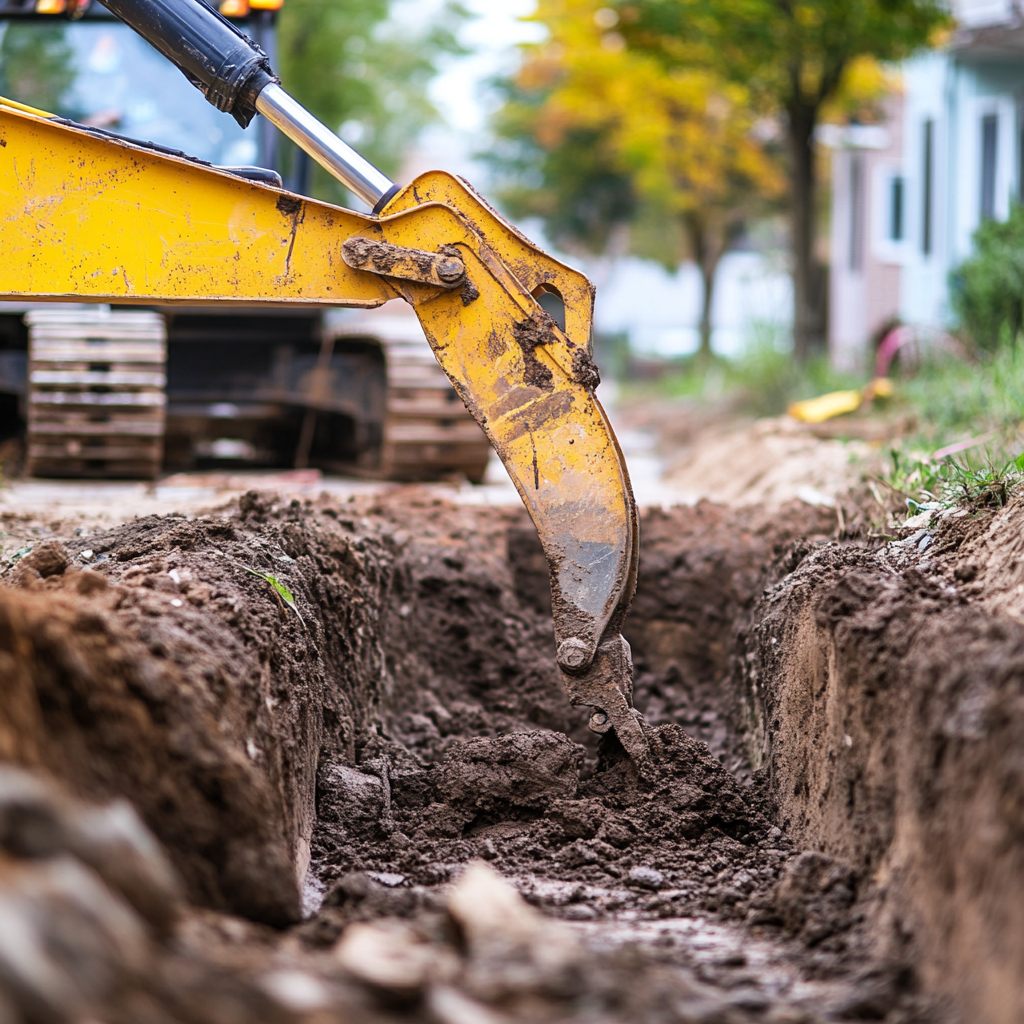Tapping into the Potential of Geothermal Energy
Revolutionizing Heating & Cooling Systems
Geothermal energy is a renewable energy source that has tremendous potential to revolutionize how we heat and cool our homes, offices, and industrial facilities. By tapping into the heat energy beneath the earth's surface, geothermal systems offer a sustainable and efficient solution for providing heating and cooling. In this comprehensive guide, we'll explore geothermal energy, geothermal heat pumps, and the benefits of this renewable energy for heating and cooling systems. We'll also delve deeper into the different types of geothermal systems, their applications, the future potential of this transformative technology, and its specific adoption in New York.
Understanding Geothermal Energy
Geothermal energy refers to the heat that is stored beneath the earth's surface. This heat originates from the earth's core and is generated through various natural processes, including the radioactive decay of minerals and the residual heat from the formation of the planet. Geothermal resources can be found around the globe, and these resources have been used by civilizations for thousands of years in applications like bathing and heating.
In the modern era, geothermal energy has emerged as a valuable renewable resource for providing heating and cooling solutions. Geothermal systems are designed to harness the earth's heat to provide warmth during the winter and coolness during the summer. This sustainable energy source has proven to be both energy efficient and environmentally friendly, providing a consistent and reliable alternative to conventional energy sources.
How Geothermal Systems Work
Geothermal systems rely on the constant temperature beneath the earth's surface to provide heating and cooling. The key component of geothermal systems is the geothermal heat pump, which transfers heat between the ground and the building. Unlike traditional heating and cooling systems that rely on the combustion of fossil fuels or the use of refrigerants, geothermal heat pumps utilize the stable temperature underground to regulate indoor temperatures.
Geothermal Heat Pumps
Geothermal heat pumps are highly efficient systems that can provide both heating and cooling for residential, commercial, and industrial applications. These heat pumps consist of a heat exchanger, a heat pump unit, and a system of pipes buried underground, known as a ground loop. The ground loop allows heat to be exchanged with the earth, effectively utilizing the thermal energy stored below the surface to regulate the temperature inside the building.
In the winter, the geothermal heat pump extracts heat from the ground and transfers it into the building, providing warmth. During the summer, the system works in reverse, extracting heat from the building and transferring it back into the ground, thereby cooling the building. This efficient method of heat transfer makes geothermal systems an ideal choice for providing year-round comfort while minimizing energy consumption.
The Ground Loop System
The ground loop is a critical component of geothermal systems, acting as the conduit for transferring heat between the earth and the building. Ground loops can be installed in different configurations depending on the available land and geological conditions. Horizontal ground loops are laid out in trenches that are several feet deep, while vertical ground loops are installed in deep boreholes. The type of ground loop chosen depends on factors like land availability, soil composition, and climate.
Another variation is the pond/lake loop, which utilizes a nearby body of water as the heat exchange medium. This option is cost-effective and highly efficient if a suitable body of water is available. Each type of ground loop has its unique benefits, and selecting the right one is key to optimizing the performance of a geothermal system.
Types of Geothermal Systems
There are several types of geothermal systems, each designed to meet specific needs and conditions:
Closed Loop Systems: These are the most common type of geothermal systems and consist of a series of pipes buried underground. A fluid is circulated through the pipes to exchange heat with the earth. Closed loop systems can be installed horizontally or vertically, depending on the available space and soil conditions.
Open Loop Systems: Open loop systems use groundwater as the heat exchange fluid. Water is pumped from a well, passed through the heat pump, and then returned to the ground. These systems are highly efficient but require an adequate supply of clean groundwater. Open loop systems are often used in areas with abundant and accessible groundwater sources.
Enhanced Geothermal Systems: Enhanced geothermal systems (EGS) involve artificially increasing the permeability of rock formations to allow for more effective heat extraction. This technology is still in development but has the potential to significantly expand the availability of geothermal resources. EGS could potentially open up geothermal energy to regions that were previously unsuitable due to limited natural permeability.










Benefits of Geothermal Energy for Heating & Cooling
Energy Efficiency: Geothermal systems are known for their high energy efficiency. By leveraging the stable temperature underground, geothermal heat pumps can achieve efficiency rates of up to 400%, meaning they produce four units of energy for every unit of electricity used. This makes geothermal heating and cooling one of the most energy-efficient options available. The Environmental Protection Agency (EPA) has recognized geothermal systems as one of the most efficient methods of heating and cooling.
Reduced Heating and Cooling Costs: While the initial cost of installing a geothermal system can be high, the long-term savings are substantial. The reduced energy consumption leads to lower utility bills, which can result in significant savings over the lifetime of the system. Studies have shown that homeowners can save up to 70% on heating costs and up to 50% on cooling costs compared to traditional systems.
Environmentally Friendly: Geothermal energy is a renewable energy source that produces no greenhouse gas emissions during operation. By utilizing the heat stored in the earth, geothermal systems help reduce the carbon footprint associated with traditional heating and cooling methods that rely on fossil fuels. This makes geothermal energy a key player in the fight against climate change and in reducing overall greenhouse gas emissions.
Reliable and Consistent: Unlike solar or wind energy, which can be intermittent, geothermal energy is available 24/7, regardless of weather conditions. This makes geothermal systems a reliable source of heating and cooling throughout the year. Geothermal energy systems do not depend on external factors like sunlight or wind, ensuring consistent performance and energy output.
Longevity: Geothermal systems are built to last. The underground components, such as the ground loop, have a lifespan of 50 years or more, while the heat pump unit typically lasts 20-25 years. This long lifespan makes geothermal systems a durable and cost-effective investment. The long-term reliability of geothermal systems means fewer replacements and less maintenance compared to conventional HVAC systems.
Quiet Operation: Geothermal systems operate much more quietly than traditional heating and cooling systems. The heat pump unit is typically installed indoors, and the absence of an outdoor condenser unit means less noise. This makes geothermal systems ideal for residential applications where noise reduction is a priority.
Geothermal Energy and Its Applications
Geothermal energy is not only used for heating and cooling individual buildings but also has broader applications in district heating, industrial processes, and electricity generation. In district heating systems, geothermal energy is used to provide heating to multiple buildings through a centralized distribution network. This approach is particularly popular in areas with abundant geothermal resources, such as Iceland, where geothermal energy meets nearly 90% of the nation's space heating needs.
Industrial Applications: Geothermal energy can also be used in industrial processes that require moderate temperatures, such as drying crops, pasteurizing milk, and other manufacturing processes. By integrating geothermal energy into industrial processes, companies can reduce their dependence on fossil fuels and improve their overall energy efficiency.
Geothermal Power Plants: Geothermal power plants are another important application of geothermal energy. These power plants generate electricity by using steam produced from geothermal reservoirs. There are several types of geothermal power plants, including dry steam plants, flash plants, and binary cycle power plants, each designed to utilize geothermal resources effectively for electricity generation. The ability to generate electricity from geothermal resources makes it a versatile and valuable renewable energy source.
Dry Steam Plants: These are the oldest type of geothermal power plants and use steam directly from geothermal reservoirs to turn turbines and generate electricity.
Flash Plants: Flash plants take high-pressure hot water from the ground, reduce the pressure, and use the resulting steam to drive a turbine.
Binary Cycle Power Plants: In binary cycle power plants, geothermal water is used to heat a secondary fluid with a lower boiling point, which then vaporizes and drives a turbine. This type of power plant is suitable for lower temperature geothermal resources and is more common in areas where geothermal temperatures are not as high.
Geothermal Energy in New York
New York is emerging as a leader in adopting geothermal energy to meet its heating and cooling needs. As part of its push towards renewable energy sources and reducing greenhouse gas emissions, the state has been actively promoting the adoption of geothermal systems for residential, commercial, and institutional buildings.
State Incentives and Support
New York has implemented several programs and incentives to support the adoption of geothermal energy systems. The New York State Energy Research and Development Authority (NYSERDA) offers financial incentives and rebates to homeowners and businesses looking to install geothermal heat pumps. These incentives help offset the high initial costs associated with geothermal installations, making it more affordable for property owners to transition to renewable heating and cooling solutions.
Additionally, the state’s Clean Heat Program is designed to encourage the use of heat pumps, including geothermal heat pumps, as an alternative to fossil fuel-based heating systems. The program offers rebates for both new installations and retrofits, supporting the state's goal of achieving a carbon-neutral economy by 2050.
Geothermal Adoption in Urban Areas
Geothermal energy is not limited to rural areas—urban areas like New York City are also exploring ways to integrate geothermal systems. Given the dense population and the limited availability of land, vertical closed loop systems are often preferred in urban environments. These systems require less surface area, making them ideal for densely populated areas with limited space.
New York City has seen a growing interest in geothermal energy as building owners look for ways to comply with Local Law 97, which aims to reduce carbon emissions from large buildings. By adopting geothermal heating and cooling systems, building owners can significantly reduce their energy consumption and carbon footprint, helping the city achieve its ambitious emissions reduction targets.
Notable Projects in New York
Several notable geothermal projects have been implemented across New York State. For example, the geothermal system at St. Patrick's Cathedral in Manhattan provides efficient heating and cooling to the historic building while preserving its architectural integrity. This project showcases how geothermal energy can be effectively integrated into existing structures, even in urban areas with limited space.
Another significant project is the use of geothermal energy at the State University of New York (SUNY) campuses. SUNY has been incorporating geothermal systems to reduce their carbon footprint and provide sustainable heating and cooling for their facilities. The adoption of geothermal energy at educational institutions demonstrates the potential of this technology to support large-scale energy needs while contributing to sustainability goals.
Overcoming Challenges with Geothermal Energy in Urban Environments
Urban environments present unique challenges for geothermal energy adoption, particularly due to limited land availability and the dense built environment. However, several innovative solutions have been developed to address these challenges and make geothermal energy a viable option in cities like New York.
One solution is the use of vertical borehole systems, which require much less surface area compared to horizontal systems. Vertical closed-loop systems involve drilling deep boreholes, which can extend hundreds of feet into the ground, allowing for efficient heat exchange without requiring extensive horizontal space. This makes them ideal for urban settings where land is scarce.
Another approach is hybrid geothermal systems that combine geothermal heat pumps with other renewable technologies, such as solar thermal systems. This hybrid approach helps enhance overall energy efficiency while reducing the reliance on traditional fossil fuels for heating and cooling.
In addition, shared geothermal loops are gaining traction in urban areas. In these systems, multiple buildings share a common geothermal ground loop, reducing the overall cost of installation and making geothermal energy more accessible for smaller buildings and residential complexes. By sharing infrastructure, urban communities can benefit from sustainable heating and cooling solutions at a lower cost.
The adoption of these innovative solutions has made geothermal energy increasingly practical in urban environments, allowing cities like New York to tap into renewable resources and work towards reducing carbon emissions effectively.
Geothermal Energy and Job Creation in New York
The push towards geothermal energy in New York is not only beneficial for the environment but also creates economic opportunities. The adoption of geothermal systems has spurred job creation in various sectors, including engineering, construction, and maintenance. As more buildings convert to geothermal systems, the demand for skilled workers who can install, maintain, and service these systems continues to grow.
Training programs have been established across New York to equip workers with the skills needed to work in the renewable energy sector. NYSERDA, along with local educational institutions, offers specialized training courses to help individuals develop expertise in geothermal energy systems. This focus on workforce development is crucial for ensuring that New York has a skilled labor force capable of meeting the growing demand for geothermal installations.
The Future of Geothermal Energy in New York
Looking ahead, the future of geothermal energy in New York is promising. The state's commitment to achieving carbon neutrality by 2050 places geothermal energy at the forefront of its renewable energy strategy. Advances in technology, such as enhanced geothermal systems (EGS), are expected to make geothermal energy even more accessible and efficient, opening up new possibilities for heating and cooling across the state.
Challenges and Future Potential of Geothermal Energy
While geothermal energy offers numerous benefits, there are also challenges associated with its widespread adoption. The initial cost of installing geothermal systems can be a barrier for many homeowners and businesses. Drilling and installing the ground loops require specialized equipment and expertise, which can add to the overall cost. However, government incentives and rebates are available in many regions to help offset these initial costs.
Additionally, the availability of geothermal resources can be limited by geological conditions, making it difficult to implement geothermal solutions in certain areas. Not all locations have the right combination of temperature, permeability, and groundwater availability to support geothermal energy extraction.
Future Potential: Advancements in geothermal technology, such as enhanced geothermal systems (EGS), hold great promise for overcoming these challenges. By increasing the permeability of rock formations, enhanced geothermal systems can unlock new geothermal resources, making this renewable energy source accessible to more regions around the world. Researchers are also exploring the potential of using abandoned oil and gas wells for geothermal energy extraction, which could provide a new source of renewable energy while repurposing existing infrastructure.
Geothermal Systems vs. Traditional HVAC Systems
When compared to traditional HVAC (heating, ventilation, and air conditioning) systems, geothermal systems offer several advantages. Traditional systems often rely on fossil fuels, which contribute to greenhouse gas emissions and are subject to price volatility. Geothermal systems, on the other hand, use a renewable energy source that is not only cleaner but also more stable in terms of cost.
Geothermal systems are also more energy efficient than traditional HVAC systems, which typically operate at lower efficiency rates. By utilizing the consistent temperature underground, geothermal heat pumps can achieve higher efficiency levels, resulting in lower energy consumption and reduced heating and cooling costs.
Geothermal energy has the potential to revolutionize the way we heat and cool our buildings. By tapping into the heat beneath the earth's surface, geothermal systems provide an energy-efficient, environmentally friendly, and reliable solution for heating and cooling. Whether used in individual homes, commercial buildings, or district heating networks, geothermal energy is paving the way for a more sustainable future.
New York is at the forefront of adopting geothermal energy, with state incentives and notable projects leading the charge. As technology continues to advance and the demand for renewable energy sources grows, geothermal energy will play an increasingly important role in meeting our heating and cooling needs. By investing in geothermal systems, we can reduce our reliance on fossil fuels, lower our carbon footprint, and create a more energy-efficient world.

